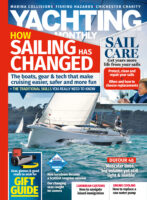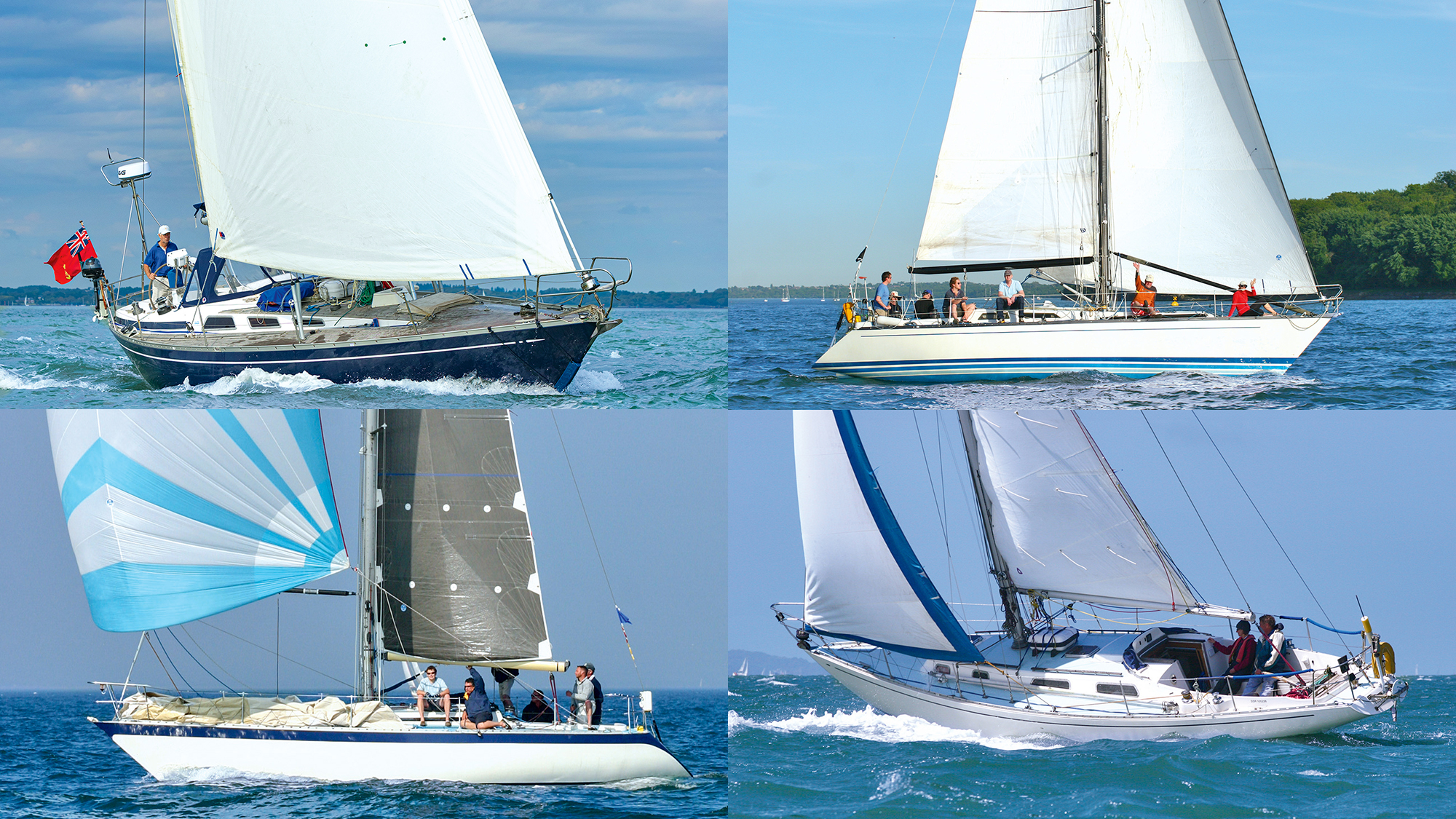X-Yachts have taken a bold move to replace their cruising range and move to a semi deck saloon design, but has the gamble paid off? Theo Stocker tests the Xc47 to find out
X-Yachts Xc47 review: A whole new concept
Rarely do boatbuilders start with a genuinely blank sheet of paper. The time and capital required to develop an all new boat make it a serious commitment, and the stakes for getting it right
are high. With the Xc47, X-Yachts have not only developed a boat that is entirely new, they have also developed a new concept of boat and stepped into a new market segment, which, in the conservative world of Scandinavian boat building, is a gutsy move.
Now, a semi deck-saloon yacht from a yard with a pedigree in cruiser racers may well divide opinion.
If you cut your teeth racing on an X-79, X-99 or X-332 – some of the yard’s most successful and popular racing boats of the last 46 years – then a 15-tonne blue-water cruiser complete with freezer, washing machine and sparkling filtered water on tap might be something of an anathema, aside from a brief foray into blue-water cruising with the X-73 deck saloon, of which two were built in 2001.
For X-Yachts, however, it is the more comfortable, heavier displacement cruising boats that have sustained the business through thick and thin with steady, consistent orders since the Xc range was launched with the Xc45 in 2008, followed by a 38, 42 and 50. Perhaps it is that new racing boats are more a ‘discretionary’ spend when things are going well.
If you’ve got £1.2million in loose change and dream of setting off on cruising adventures, then you’ll be fixed on setting sail whatever the economic climate, and a more conservative experience on the water may mean your family is more likely to be in on the dream.

The cockpit is secure and comfortable underway, and sociable in harbour. Photo: Paul Wyeth
X-Yachts felt that hull design and sailors’ expectations have moved on sufficiently to warrant an all new model with the aim of ‘supercharging’ what the Xc boats already did well. To that end, hull volume has grown forward and aft, topsides and coachroof are higher, while a deep V forefoot, rounded mid sections and pronounced rocker have been retained and developed.
The stern overhang has been made higher and longer with an enclosed stern to aid seaworthiness in the rough stuff and to tolerate being loaded up with cruising kit and full tanks. The boat we tested, 15 tonnes unladen, when lifted recently with full tanks and all kit on board, weighed in at 17 tonnes, yet her sailing characteristics have been little affected, compared to the impact a 10%-plus weight increase would have a light-weight racing hull.
The raised saloon is the biggest departure. Okay, it’s not a true deck saloon, in that the saloon is still down in the belly of the boat, but a two-level coachroof and huge windows – as well as a full-width forward-facing window abaft the mast, and hull windows in every space on board – mean that light and views pour into a highly original layout.
Then there’s the sheer attention to detail that has been paid to almost every single feature of the boat. The whole boat was mocked up in wood and refined until the Danes were happy that they had a boat that was just right, from the very first hull.
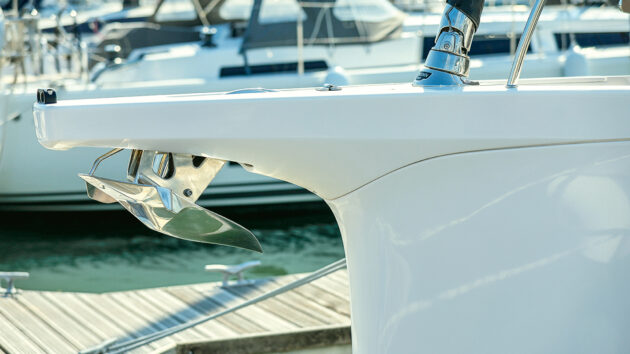
The moulded bowsprit flows smoothly into the hullform. Photo: Paul Wyeth
Little things like the niche to comfortably fit your feet under the chart table drawers, the instrument pedestals at the helm that are angled to make the plotter easier to see and provide a comfortable backrest for crew facing forward. The same approach was applied to engineering, systems, and even upholstery, with possibly the comfiest sofa afloat that I’ve ever lounged on. Not to mention drinks cabinets, projector screens and bilge pumps…
Ghosting along
Out on the water, the promised breeze was struggled to materialise against a fledging sea-breeze, the result of which was… very little, leaving us hunting around the Solent for zephyrs. It was disappointing not to be able to thrash this offshore-capable boat about a bit to see what she could do, meaning the deep third reef and removable inner forestay went untested. A light wind test will, however, tell you how easily-driven a hull is.
The magic number of 8 knots of true wind to get properly moving seemed about right for a boat of this gravitas. On the wind, an apparent wind of 10-14 knots had boat speed nudging up over 7.5 knots.
Article continues below…
X Yachts XC38
360º images to drag and scroll your way around to explore the interior of the X Yachts XC38
4 of the best traditional 37 and 38ft yachts compared
The Swan 38 has quite the reputation as being a real sailors’ boat, but there are a number of other…
Under asymmetric spinnaker, set from the end of the integrated bowsprit, we were similarly up over 7 knots in just 8 knots of apparent breeze, and still managed 4.5 knots in just 5 knots of apparent.
The polars suggest cruising speeds of 7-9 knots in anything over 12 knots of breeze, with nearly 11 knots being achievable off the wind, and our test was in line with these figures for lighter airs.
Whatever puffs met the boat were rapidly converted into acceleration, helped by a lovely set of stretch-free 3Di sails from North. The flatter foot of an in-boom furled mainsail didn’t seem to impact this unduly.
Powered up, the boat initially had a tad more weather helm than I’d have liked, easily remedied with backstay and halyard tension. Sail twist can be managed with the jib car tracks and the mainsheet traveller mounted forward of the companionway, though this far forward, it is more set-and-forget than one to play through the gusts.
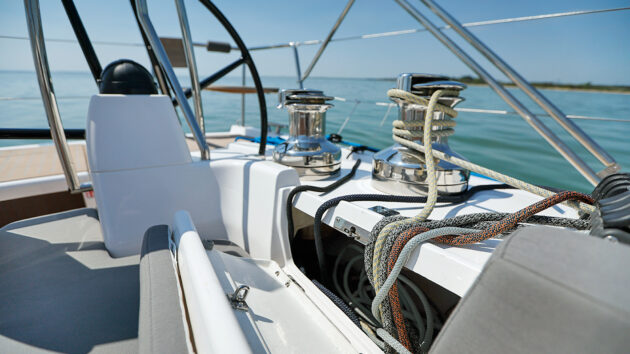
The coaming backrest folds down to reveal a deep rope bin. Photo: Paul Wyeth
Similarly, the recessed jib tracks allow adjustment for twist for the full jib with a stopper on the car but aren’t long enough to tighten the leach of a partially furled headsail, which is where the removable inner forestay for a working- or storm-jib comes in.
Twin composite wheels ensure that the helm stays light and responsive, and Jefa steering links them to the single deep rudder. Clearly a 15-tonne vessel has a certain mass to it that can be felt through the helm, but for a boat of this displacement everything felt precise, accurate and responsive, with enough feedback to know if the boat was balanced.
Downwind, 190m2 of bright orange asymmetric pulled us along beautifully even as the water turned glassy.
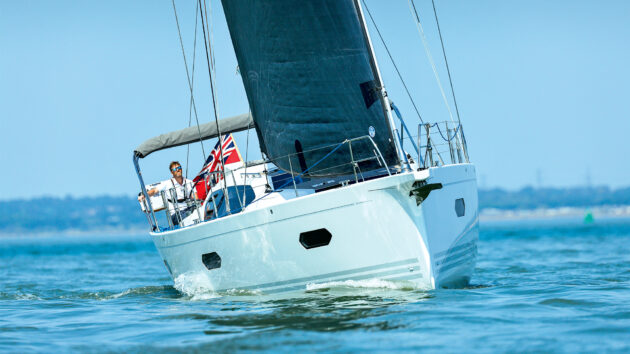
A powerful rig and a slippery hull kept the boat sailing in very light airs. Photo: Paul Wyeth
All to hand
Helming was comfortable, whether sitting outboard, standing on the lifting footrest or sitting behind the wheel, with all of the controls needed close to hand. Twin powered Andersen winches (58ST primaries and 52ST secondaries) made light work of hoisting and sheeting in the sails, while the rope bins neatly hidden behind coaming backrests easily swallowed halyard tails. A dozen lines can be led aft, six either side, so if you did opt for a slab reefed main, some systems could be switched to hydraulic to save on clutches, such as vang or halyard tension.
The raised console for the chartplotter, inboard of the grab hold and crew backrest, worked extremely well and viewing angles were much better than on a flat pedestal mount, with additional space for systems such as engine start, autopilot and anchor counter were in the aft end of the cockpit table.
My main impression of the cockpit was one of security, in large part thanks to the transom being enclosed with seats wide enough to make two nice sunbathing spaces in harbour. These housed a cavernous step-in lazarette with space for a folded up dinghy, paddleboards, a few wing foilers, fenders and the liferaft which rises up on a gas strut when needed. Next to this is a gas locker large enough for two large Calor bottles. Induction cooking is an option, but the owner reckoned his Quooker tap meant the kettle would rarely be need for hot drinks.
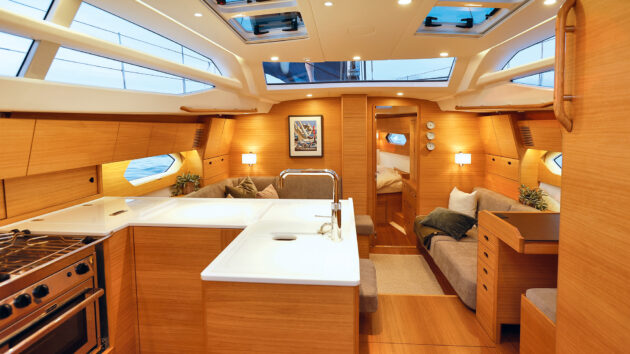
This is the first X-Yacht with a stepped cabin sole. The stbd settee has deeper, softer cushions for slouching. Photo: Paul Wyeth
The sole-depth locker on port side is a useful shallow locker for power cables, covers and the like. Despite the boat’s beam, the cockpit has been kept a sensible width so that crew can brace easily, while long benches mean there’s plenty of room to stretch out. The table incorporates a deep cool box and large folding leaves, making it a great space to eat and socialise.
There are a few cup holders in this, and stowage for small items in a stack of little cubby holes behind the hinged companionway doors; a small cubby hole aft somewhere for phones and binoculars would be a useful addition.
While the cockpit sole is relatively high to make space for berths below, the raised coachroof provides decent shelter and a comfortable back rest without obscuring the helm’s view when seated. We didn’t use it while sailing, but the sprayhood is low enough to see over, and with a long overhang so that the forward end of the cockpit is protected, with a bimini for extra cover.
Stepping out onto the wide side decks is easier aft of the wheels where there are plenty of hand holds. An extra handhold would have made stepping over the wide coamings at the forward end of the cockpit feel a little more secure.

All you need at the chart table. Note the recess for your feet under the drawers. Photo: Paul Wyeth
Moulded bulwarks, wide side decks, a clear walk through between the split chain plates, and coach-roof mounted jib tracks (hidden below hinged panels) keep the side decks completely clear for moving about, while the Flexiteek decks provided decent grip. At the bow, the large anchor locker swallowed 100m of chain with plenty of room to spare, while the forepeak locker had room for a couple of offwind sails as well as fenders and lines.
Having anchored up in Newtown Creek for a light supper while we waited for the breeze to fill in, we had time to test one final area that has received significant design attention. Every cruiser relies heavily on their tender, and the dinghy davit system was amazingly simple but highly effective.
Small stainless steel davits attach to the top edge of the bathing platform, engineered to take the additional loads. The dinghy is lowered by dropping the electric platform. When the dinghy touches the water, the davit arms hinge upwards, pushing the boat out away from the platform.
The dinghy can then be unclipped and the arms folded back on themselves. Hooking the separate bathing ladder onto the platform made for easy climbing aboard after I’d been for a quick swim (all for editorial thoroughness, of course).

Abundant stowage surrounding the bigger-than-super-king-sized forward berth makes long-term living aboard realistic. Photo: Paul Wyeth
Room with a view
Heading below, the benefits of the raised windows and stepped cabin sole (a first for X-Yachts) were immediately apparent, with stunning views out and a generous 205cm (6ft 6in) of headroom.
The halyard ducting bisects the main windows (keeping the halyard runs straight and friction-free) where they provide reinforcement for the windows and a grab rail for moving around. It was a detail I liked, and it wasn’t detrimental to enjoying the view while using the large galley, which has three columns of deep drawers, a fridge and a freezer, a three-burner oven and a double sink on the centreline. Ventilation is from the four large hatches in the coachroof, and two small ports that open above the galley, protected by external louvres so they can be opened in rain or at sea.
Ventilation in the cabins is good too, though I’d have liked an opening hatch or dorade vents at the forward end of the saloon.
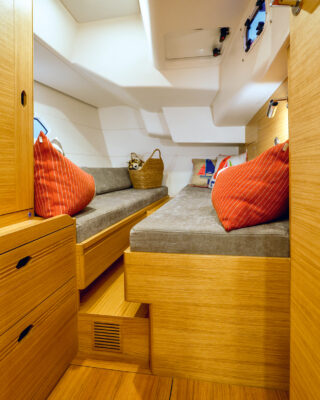
An infill converts two twin berths into a large double, with large lockers below Note the foot recesses to make sitting down on a single bed more comfortable. Photo: Paul Wyeth
I was pleased to find a proper forward-facing chart table where electrics and electronics could all be controlled and monitored. This boat’s owner had opted to for an iPad to mirror the on-deck plotters rather than installing a separate plotter in the eye-level console, leaving space inside the boxing for an additional book locker.
Stepping down into the saloon there’s even more headroom (220cm / 7ft 3in), where deep, soft sofa to starboard is one of the comfiest you will ever find afloat, and the large c-shaped seating to port can, with the addition of the moveable seat from the chart table, accommodate eight if you unfold and spin the coffee table to become a full size dining table. Drop this down and the whole area becomes a large day bed from which to watch films on the pull-up screen and projector; backrests recline for ultimate comfort.
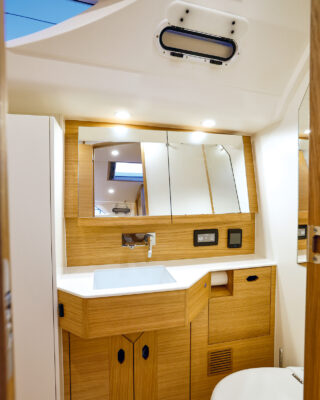
A well-appointed aft heads compartment (note the louvred opening hatches). Photo: Paul Wyeth
All of the space under these seats is given over to stowage, as are the overhead and full-height lockers around the saloon, as tanks are all accommodated under the cabin sole, where 500 litres of fuel and 640 litres of water in various tanks nestle amongst the galvanised steel keel matrix. This spreads all the rig and keel loads evenly out to the hull, which is built with vacuum-infused epoxy with solid laminate around the keel, rudder posts and through-hulls, with carbon fibre reinforcement on the chainplate structure, main bulkhead and around door frames.
Ample accommodation
The forward cabin is a worthy owner’s suite, where a larger-than-super-kingsize bed takes centre place under 210cm of headroom. Upright lockers, columns of drawers and overhead lockers provide ample stowage; below the berth are deep drawers plus more stowage, thanks to the retractable thruster being in the fo’c’sle rather than under the berth.
The aft cabins are arranged as twin cabins that can be turned into large doubles with an insert, so you could sleep six on board comfortably. Under these bunks is more deep stowage, the space managed by webbing baskets hung on rails to keep everything neat. The main locker in the starboard aft cabin was given over to a washer-dryer machine so you aren’t dependent on finding laundrettes while cruising, and this cabin can, if you prefer, be specified as a workshop with an extra freezer with workbench and vice, and a fold-down pipe cot, which may appeal to long-distance cruisers.

190m2 of canvas powers the boat along in the merest zephyr. The stern overhang has been extended to ensure the boat still sails well fully loaded. Photo: Paul Wyeth
Both the ensuite heads in the owner’s cabin and the main aft heads are large enough to include separate shower compartments, decent amounts of locker space, and good ventilation, as well as fresh- and salt-water electric flushing toilets, mounted fore and aft.
Engine access is good, even with the calorifier above it. The only frustration is having the water strainer at the aft end of the compartment. The space between the two aft cabins means there’s ample room for a stern thruster and a generator if you wanted them.
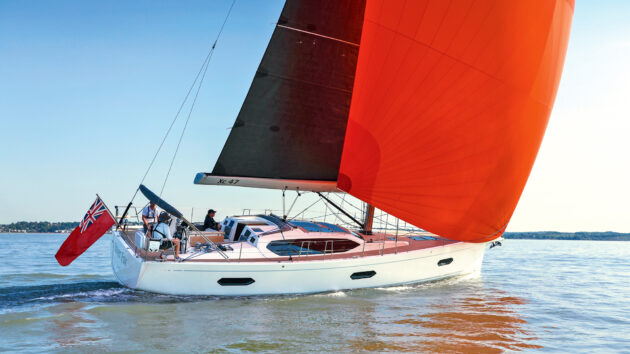
This is a boat that inspires confidence while still being rewarding to sail. Photo: Paul Wyeth
X-Yachts Xc47 specifications
LOA: 15.21m / 49ft 11in
Hull length: 14.37m / 47ft 2in
LWL: 13.17m / 43ft 2in
Beam: 4.56m / 15ft 0in
Draught: 2.30m / 7ft 7in (Shoal 2.00m / 6ft 7in)
Displacement: 14,900kg / 32,849lbs
Ballast: 5,490kg / 12,103 lbs
Sail area: 124m2 / 1,337 sq ft
Bal/disp: 37%
Disp/length ratio: 177
SA/D Ratio: 21.2
Engine: 80hp
Transmission: Saildrive
Water: 640L
Fuel: 500L / 132gal
RCD: Category A
Designer: X-Yachts Design
Builder: X-Yachts Denmark
Enjoyed reading this?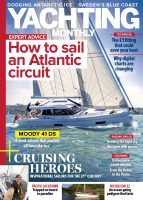
A subscription to Yachting Monthly magazine costs around 40% less than the cover price, so you can save money compared to buying single issues.
Print and digital editions are available through Magazines Direct – where you can also find the latest deals.
YM is packed with information to help you get the most from your time on the water.
-
-
- Take your seamanship to the next level with tips, advice and skills from our experts
- Impartial in-depth reviews of the latest yachts and equipment
- Cruising guides to help you reach those dream destinations
-
Follow us on Facebook, Twitter and Instagram.
Note: We may earn a commission when you buy through links on our site, at no extra cost to you. This doesn’t affect our editorial independence.

